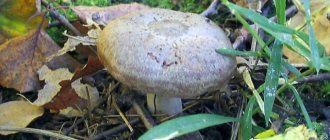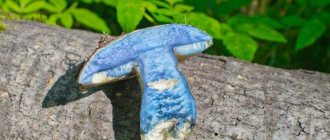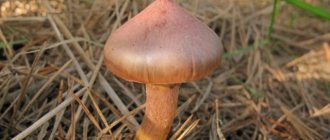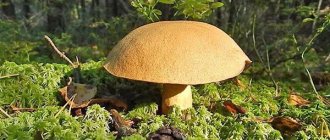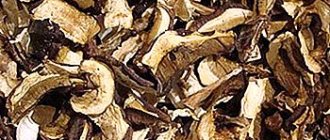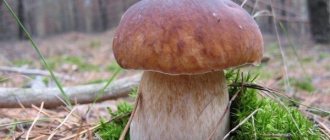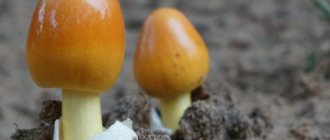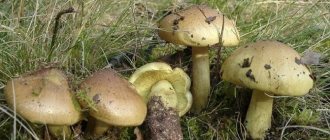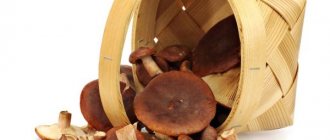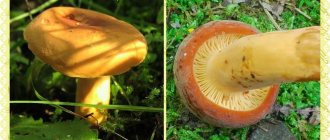Common milkweed: photo and description
Milky mushrooms are lamellar mushrooms of the Russula family. The radius of the mushroom cap can be from 4 to 11 centimeters. Its surface always shines, even in sunny but dry weather. Circles are visible on top of it. As the mushroom ages, the color of the cap also changes. If young representatives have a dark bluish color and a convex cap shape, then the old ones acquire a purple or brown color, and subsequently yellow and rusty. The cap gradually becomes flatter and even depressed. Its surface is quite dense, and sometimes there are even pits on it. The edges of the cap can be wavy or curved, and often even curl inward.
The height of the leg reaches 8-10 centimeters. It can be colored gray or red. The shape of the leg is cylindrical. But inside she is empty. The common milkweed has incredibly brittle but dense flesh. It crumbles easily. This is due to the fact that there are practically no fibers in its composition. The flesh inside the mushroom is white, but near the surface it is colored brown. The milky juice makes it bitter. When it comes into contact with air, the milky liquid turns yellow.
Most of the milkweeds were considered inedible by experts because their juice was too caustic. However, it is incredibly difficult to distinguish between different types of mushroom because they are so similar. Even experienced mushroom pickers do not always cope with this task. Therefore, novice mushroom pickers should not take them into the basket at all. There are no doppelgängers in lacticians.
People call these mushrooms differently: alder mushrooms, smooth mushrooms, hollow mushrooms, gray milk mushrooms, yellow hollow mushrooms.
Milky lilac
The cap is 5-8 (10) cm in diameter, thin-fleshy, initially flat, then flat-prostrate with a sharp papillary tubercle. The edge is initially lowered, then becomes straight, sharp, smooth. The skin is dry, thin tomentose-scaly, pale lilac, from dark lilac-pink to red, fading with age to lilac-pinkish, flesh-lilac. The plates are descending, frequent, forked, with plates, pinkish-ocher. The milky juice is white; the color does not change in air. The stem is 3-7 x 0.4-1 cm, cylindrical, sometimes widened towards the base, brittle, hollow, pinkish-ochreous. The pulp is whitish, initially sweetish in taste, then slowly acrid, without much odor. The spore powder is white (in young specimens) to creamy (in old specimens).
The lilac milkweed forms an association with alder (Alnus Mill.). Grows in alder forests, in small groups, on soil and wood, infrequently, in August - September. Inedible.
Where do milkies grow?
The first common milkweeds appear in the second half of July. You can collect them until the end of September. Mushrooms grow actively, of course, in damp, rainy weather. They prefer damp places, which is why they grow in lowlands in mixed, coniferous and deciduous forests. As a rule, they are collected under birch or coniferous trees. Mushrooms hide in moss or tall grass. Insects do not touch the lacticaria. Mushrooms also grow along the banks of ponds and swamps. But mushrooms do not like hot regions, preferring more moderate latitudes. Therefore, they are found in the forests of European countries, in the central and middle regions of Russia, in the Urals, Western Siberia and even in the Far East.
The common lacticaria mushroom (photos and descriptions are given in the article) has many types. However, as already mentioned, outwardly it is quite difficult to distinguish them. Therefore, it is worth looking at some varieties in more detail.
Growing milkweed at home
Thanks to the unpretentiousness of the milkweed, it is easy to grow a good harvest of mushrooms at home. All you need for planting is mycelium and a suitable place. It is better to plant mushrooms in a shaded area of the garden; it is great if there are several coniferous trees growing there.
Before planting, prepare the soil - dig long trenches up to 30 cm deep, fill them with forest soil mixed with rotted compost. Spread the mycelium in the trenches (you can combine it with a small amount of prepared soil). Water thoroughly and sprinkle with a thin layer of forest soil. You can cover mushroom beds with dead wood, spruce branches or pine needles.
Caring for the milkweed is simple and consists only of regular watering. If the summer is dry, moisten the mushroom beds every 3-5 days. During the rainy season, watering will not be needed - the mycelium may rot.
The first mushrooms will appear a few months after planting. You can get three harvests per season by collecting milkweed every 2-3 weeks.
The milkweed is a wonderful mushroom that, if properly prepared, will take its rightful place on the table. Traditional medicine also recommends not to abandon the use of this representative of the mushroom family in home treatment. Tinctures and decoctions will serve as effective adjuncts to drug therapy prescribed by specialists.
Hot milky mushroom
The stinging milkweed is a conditionally edible species. It is very rarely found in our forests. As a rule, it grows on clay soils. It can also grow in well-lit forests among shrubs. Most mushrooms grow singly and only occasionally in groups. You can meet them from early August to early October. The mushroom has a small cap, the diameter of which is approximately six centimeters. It is smooth to the touch and slightly concave in the center. On top it is painted gray-beige. The mushroom contains a very caustic milky juice that does not change color when in contact with air. The stem of the mushroom is painted the same color as the cap. This type of milkweed belongs to the third category. Such mushrooms can only be salted, and they must first be boiled or soaked.
Types of lacticaria mushroom
Acute milkweed (Lactarius acérrimus)
Conditionally edible mushroom.
The cap is 2-10 cm in diameter, smooth, with a wavy edge. The skin is moist, bare, smooth, ocher, dark in the center, with concentric zones. The leg is up to 10 cm high, 1.5 cm in diameter, cylindrical, hollow, hard, bare, smooth, lighter than the cap. The pulp is dense, white, pungent, and the smell is not pronounced. The milky juice is white and does not change in air.
Acute milkweed (Lactarius ácris)
A conditionally edible mushroom, used salted. Before cooking, soak or boil for a long time.
The cap is 3-7 cm in diameter, the shape is convex, later spread out, the surface is lumpy, dry, velvety, the edge is wavy. The color is brownish-gray. The leg is 3-5 cm in height, up to 1.5 cm in thickness, cylindrical in shape, tapering towards the base, dense, velvety, grayish-cream. The pulp is white, dense, red when cut, the taste is hot and pungent, there is no smell. The milky sap is abundant, thick, white, and becomes bright coral in the air.
The mushroom grows in small groups in deciduous, broad-leaved, and sometimes in mixed forests of Eurasia. The season lasts from July to September.
Alpine milkweed (Lactarius alpinus)
Conditionally edible mushroom.
The cap is 3-6 cm in diameter, in a young mushroom it is convex, the edge is tucked, later depressed with a tubercle in the center and a wavy edge. The skin is dry, scaly, ocher. The stem is 2-4 cm in height, up to 0.5 cm in thickness, cylindrical in shape, the color matches the cap. The pulp is dense, white, has a pungent taste and no odor. The milky juice is white and does not change in air.
Grows in open forests, in groups, in Eurasia, North America. Fruits in August.
Thyroid milky (Lactarius aspideus)
Conditionally edible mushroom.
The cap is 3-8 cm in diameter, in young mushrooms it is convex, the edge is pubescent, later depressed with a smooth edge. The skin is slimy, yellowish in color, with purple spots. The leg is 3-5 cm in height, up to 1.5 cm in diameter, cylindrical in shape, hard, hollow, mucous, the color matches the cap. The pulp is white, dense, fresh, the smell is not pronounced. The milky sap is white and turns purple in the air.
It grows in groups in deciduous and mixed with birch forests of Eurasia and North America. The season continues in August-September.
Orange-ochre milky (Lactarius aurantiacoochráceus)
Conditionally edible mushroom.
The cap is 8-10 cm in diameter, thick, depressed, the edge is turned up, fringed. The skin is sticky, smooth, glabrous, orange-ocher in color, with concentric zones. The leg is 6-10 cm in height, up to 3 cm in thickness, cylindrical in shape, smooth, dry, hollow, light ocher in color. The pulp is light ocher in color, dense, the taste is sharp, the smell is not pronounced. The milky juice is white and does not change in air.
Grows in small groups in mixed forests of Eurasia in September.
Zoneless milkweed (Lactarius azonites)
Conditionally edible mushroom.
The diameter of the cap is 3-9 cm, the shape is flat or depressed with a tubercle, the edge is smooth. The skin is dry, velvety, brown or sandy. The leg is 3-7 cm high, up to 1 cm thick, cylindrical in shape, hard, bare, color like a cap. The pulp is white, dense, fresh, no smell. The milky sap is white and turns pink in the air.
Distributed in deciduous and mixed forests of Eurasia. Grows in large groups from August to September.
Bertillon's milkweed (Lactarius bertillónii)
Conditionally edible mushroom.
The hat is 13-18 cm in diameter, flat, the edge is turned up. The surface is dry, pubescent, white or cream in color, later with brown spots. The pulp is fleshy, hard, white, has a pungent taste, a sour-fruity smell, unpleasant. The milky juice is white or creamy. The leg is cylindrical, tapering downward, 3-7 cm in height, 2-4 cm in diameter, solid. The surface is bare, white.
Grows in deciduous forests of Eurasia.
Camphor milkweed (Lactarius camphoratus)
Conditionally edible mushroom.
The cap is 3-6 cm in diameter, in a young mushroom it is convex, the edge is curved, later it is spread out or depressed, the edge is ribbed. The color of the cap is reddish-brown, the surface is smooth, matte. The leg is about 0.6 cm thick, 3-5 cm high, cylindrical in shape, thin, color like a cap. The pulp is loose, brittle, reddish-brown in color, the smell is unpleasant, camphorous, the taste is insipid or sweetish. The milky juice is abundant, whitish, and does not change in air.
Grows in coniferous, mixed and deciduous forests in the temperate zone of Eurasia and North America. The season lasts from August to September.
Lactarius circellatatus
Conditionally edible mushroom.
The cap is 3-8 cm in diameter, flat, then depressed, thin-fleshy, the edge is wavy. The skin is sticky, gray, with concentric circles. The leg is 4-8 cm high and 0.7-1.5 cm thick, cylindrical, hollow, hard, brown in color. The pulp is white, dense, the smell is not pronounced, the taste is sharp. The milky juice is white.
Distributed in mixed and deciduous forests, grows in small groups in Eurasia and North America.
Brownish milkweed (Lactarius fuliginósus)
Conditionally edible mushroom.
The diameter of the cap is 4-10 cm, the shape is convex, later funnel-shaped, the edge is bent. The color of the cap is dark brown or chocolate, the surface is dry and velvety. The leg is 4-10 cm high, 1-1.5 cm thick, cylindrical, velvety, light. The pulp is whitish, turns pink when cut, dense, fragile. The smell is weak, fruity, the taste is pungent. The milky juice is thick, white, and turns pink in the air.
Mycorrhiza forms with oak and beech. Distributed in deciduous forests of Europe. Fruiting begins in July and lasts until mid-September.
Fragrant milkweed (Lactarius glyciosmus)
Conditionally edible mushroom.
The cap is 3-6 cm in diameter, the shape is convex, later flattened, the edge is turned up, the color is flesh-gray. The surface is dry, pubescent. The leg is 0.5-1 cm in diameter, high, smooth, loose, light. The pulp is white, fresh, and has a coconut aroma. The milky juice is white and does not change in air.
Grows in deciduous and mixed forests, from August to October.
Lactarius hygrophoroides
Conditionally edible mushroom.
The cap is 4-8 cm in diameter, dry, convex in shape, in the old mushroom it is flat or depressed, orange-brown. The leg is 0.5-1.5 cm thick, 3-7 cm tall, orange-brown in color. The pulp is brittle and white.
Grows in forests, next to oak trees.
Blue milky (Lactarius indigo)
A conditionally edible mushroom, common in North and Central America and Asia.
The diameter of the cap is 5-15 cm, the color is blue, the shape is convex, gradually becoming depressed. The edge is turned up. The surface is sticky. The leg is 2-6 cm high, 1-2.5 cm in diameter, cylindrical, the color matches the cap. The pulp is light or bluish. The milky juice is blue, acrid, and turns green in the air. There is no smell.
Grows in deciduous and coniferous forests.
Brown milkweed (Lactarius lignyotus)
Conditionally edible mushroom.
The cap is 3-7 cm in diameter, convex in shape with a tubercle and a pubescent edge, later spread out. The surface is velvety, wrinkled, chestnut, brown or black-brown in color. The leg is 6-8 cm high, 0.5-2 cm thick, cylindrical in shape, solid, velvety, color like a cap. The pulp is hard, white or pale yellow, turns red when cut, and has no pronounced odor. The milky sap is non-caustic, white, and turns yellow in air.
A rare species, it grows in coniferous forests in small groups or singly. The season begins in mid-August and lasts until the end of September.
Lilac milkweed (Lactarius lilacinus)
Conditionally edible mushroom.
The cap is 4-8 cm in diameter, flat in shape, funnel-shaped in the old mushroom. The color is lilac-pink, the surface is pubescent. The stem is 3-8 cm high, 0.8-1.2 cm in diameter, cylindrical, hollow, buffy. The pulp is whitish-pink in color and has a mushroom smell. The milky juice is white, abundant, caustic.
Distributed in deciduous and coniferous forests, grows in September-October.
Yellowish milkweed (Lactarius luteolus)
Conditionally edible mushroom.
The cap is 2.5-8 cm in diameter, convex in shape, later flat, white or yellowish in color. The pulp is white, turns brown when exposed to air, the taste is insipid, the smell is unpleasant. The milky juice is white, does not change in air, sticky, abundant. The leg is 2.5-6 cm long, 0.5-1.2 cm thick, white or cream, dry, velvety.
The mushroom grows in deciduous and mixed forests of North America and Japan.
Non-caustic milkweed (Lactarius mitissimus)
Conditionally edible mushroom.
The cap is 2-6 cm in diameter; in a young mushroom it is convex, then funnel-shaped. The color is orange, the surface is velvety, dry. The stem is 3-8 cm high, 0.8-1.2 cm thick, cylindrical in shape, dense, the color matches the cap. The pulp is dense, orange, odorless. The milky juice is white, watery, and does not change color in air.
Mycorrhiza forms with birch, oak and spruce and grows from mid-July to October.
White milkweed (Lactarius músteus)
Conditionally edible mushroom.
The diameter of the cap is up to 10 cm, the shape is convex, then funnel-shaped. The surface is smooth, slimy, yellowish-white. The leg is 3-7 cm long, 1-2.5 cm in diameter, cylindrical in shape, tapering downwards, hollow, white. The pulp is white, non-acidic. The milky juice is white.
Grows in pine and mixed forests. The season lasts from August to October.
Pale milkweed (Lactarius pallidus)
Conditionally edible mushroom.
The cap is 4-12 cm in diameter, convex, funnel-shaped and depressed in old mushrooms. The surface is smooth, slimy, pale. The leg is 7-9 cm high, 1.5 cm thick, cylindrical, hollow, color like a cap. The pulp is thick, white or cream in color, the smell is pleasant, the taste is pungent. The milky juice is abundant and white.
Grows next to oak and beech from July to August.
Stinging milkweed (Lactarius pyrógalus)
Conditionally edible mushroom.
The diameter of the cap is 3-6 cm, the shape is round, the edge is turned up, wavy. The color is grayish-flesh, with concentric zones, the surface is moist, mucous. The stem is 3-5 cm high, 0.5-1 cm thick, tapers towards the base, the color matches the cap. The pulp is dense, white, the smell is weak, mushroom. The milky juice is abundant, white or yellowish in color. The taste is very spicy.
Distributed in Europe and Asia in deciduous, broad-leaved and mixed forests. Fruiting in early August and until the end of September.
Neutral milkweed (Lactarius quiétus)
Conditionally edible mushroom.
The cap is 4-8 cm in diameter, flat-convex in shape, dented in old mushrooms. The surface is dry, brown, with dark concentric zones. The stem is 3-6 cm high, 0.5-1 cm thick, cylindrical in shape, solid, color like a cap. The pulp is dense, brittle, white, later turns brown, the taste is weak, the smell is hay, specific. The milky juice is white, non-caustic.
Mycorrhiza forms only with oak. Grows abundantly in deciduous and mixed forests. The season lasts from the beginning of July to the end of September.
Spiny milkweed (Lactarius spinosulus)
Conditionally edible mushroom.
The cap is 2-6 cm in diameter, in a young mushroom it is flat-convex, the edge is curved, later it is spread out, depressed. The color of the cap is pink-red, with red concentric zones. The flesh is light and turns green with age. The milky sap is white and turns green in air. The stem is 3-5 cm high, 0.2-0.8 cm thick, curved, hollow, color like a cap.
Grows in deciduous and mixed forests, next to birch, from mid-August to late September.
Stunted milkweed (Lactarius tabidus)
Conditionally edible mushroom.
The cap is 3-5 cm in diameter, convex in shape, prostrate in old mushrooms, the surface is dry and reddish. The stem is 0.4-0.8 cm thick, 2-5 cm high, loose, later hollow, widens towards the base, the color matches the cap. The pulp has a weak pungent taste. The milky sap is white and turns yellow in air.
Distributed from July to September in mixed and deciduous forests.
Common milkweed (Lactárius triviális)
Conditionally edible mushroom.
The cap is 8-15 cm in diameter, fleshy, hemispherical or convex in shape, later flattened, mucous. Color from violet-lilac to pale-brown. The leg is 5-10 cm high, cylindrical, the color matches the cap. The pulp is white, sharp, the milky juice is white, burning.
It grows in Eurasia, in large groups, in coniferous and deciduous forests.
Faded or lethargic milkweed (Lactarius viétus)
Conditionally edible mushroom.
The cap is 3-8 cm in diameter, convex at first, grayish-brown or wine-brown in color. The leg is 3-8 cm high, cylindrical, solid, light. The pulp is white, fragile, and has a sharp taste. The milky juice is white and hot.
Found in Eurasia and North America, in large groups, in deciduous and mixed forests.
Lilac milky (Lactarius violáscens)
Conditionally edible mushroom.
The diameter of the cap is 8-15 cm, the center is depressed, the shape is funnel-shaped, the color of the cap is lilac-brown, with concentric zones. The leg is 5-10 cm high, cylindrical, hollow, cream-colored. The pulp is white, dense, and turns purple when exposed to air. The taste is island-bitter.
Grows in deciduous and mixed forests of Eurasia.
Watery milkweed (Lactarius serifluus)
Conditionally edible mushroom.
The cap is 3-7 cm in diameter, dry, buffy, flat-convex in shape, with a curved edge. The stem is 0.6-1.3 cm thick, 7 cm high, cylindrical in shape, hollow, fibrous, color like a cap. The pulp is brownish-reddish in color, brittle. The milky juice is watery and white.
Grows in August-September in mixed and deciduous forests.
Camphor milkweed
Another variety of the common lacticaria (photo is given in the article) is the camphor lacticaria. It is also rare to find such a mushroom in our forests. They do not grow alone, but gather in groups. They grow from late July to early October. The yield of mushrooms is completely independent of weather conditions. They grow in damp places in any forest.
The camphor milkweed has a convex tuberculate cap. In old mushrooms it becomes funnel-shaped. The edges of the cap are uneven, with a characteristic waviness. The color of the mushroom can be brown and reach a red-orange hue. And in the center of the cap there is a dark purple area.
Description of the milkmen
Milkies are a separate group of fungi, which has its own varieties. It includes milk mushrooms, volushki, saffron milk caps, bitter mushrooms, and serushki.
What do mushrooms look like?
The milkweed is a representative of the Russula, and has about 500 varieties. They are usually large or medium in size. Their fruiting bodies are thin or thick fleshy, but have increased fragility.
On a note! A characteristic feature of all laticifers is the presence of a mesh pattern on their spores.
Structure and features of the species
Mushrooms of this variety have the following structure and characteristics:
- Hat. The average size of a milkweed cap is 8 cm in diameter. However, sometimes you can find fruits with larger caps - from 30 to 40 cm. Some specimens have a tubercle in the center of the cap section. The edges are smooth, sometimes wavy. The color of the cap depends on the type of milkweed.
- Pulp. It has a weak and vague odor, but may be completely absent.
- Leg. Milky plants have a predominantly cylindrical stalk. The color corresponds to that characteristic of the cap section.
Milky gray-pink
This type of milk mushroom is popularly called differently - inedible mushroom, amber milk mushroom, gray-pink milk mushroom, etc. Gray-pink milk mushroom is considered an inedible mushroom.
Its cap is gray-pink in color, which is how it got its name. In diameter it can reach from 8 to 15 centimeters. The hat has a round shape. Its central part may have a tubercle or a depression. In young mushrooms, the edges of the cap are neat and curved inward. With age, the edges begin to open up. In general, the color of this type of mushroom is very difficult to describe. There are brown gray and pink shades. The surface of the hat is dry and velvety.
The flesh of the mushroom is thick and brittle. It has a very intense aroma and pungent taste. The milky juice has a watery appearance and is released in small quantities. Adult mushrooms may not contain any juice at all. The thick and short stems of the mushroom, as a rule, do not exceed 5-8 centimeters in height. In cases where the gray-pink lacticaria (photo and description are given in the article) grows in mosses, the height of the leg can be significantly greater.
Poisonous and inedible types of laticifer mushroom
Sticky milkweed (Lactarius blennius)
Inedible mushroom.
The diameter of the cap is 4-10 cm, the shape is convex, later spread out, the edge is curved. The surface of the cap is shiny, sticky, gray-green in color with dark concentric zones. The leg is 4-6 cm long, 2.5 cm in diameter, light. The pulp is white, odorless, the taste is sharp, peppery. The milky juice is thick and white.
Mycorrhiza forms with deciduous trees and grows in summer and autumn in small groups in deciduous forests of Europe and Asia.
Gray-pink milkweed (Lactarius helvus)
Inedible mushroom.
The cap is 6-12 cm in diameter, the shape is flat, later funnel-shaped, the edge is curled. The color is pinkish-brown. The stem is 9 cm high, 1.5-2 cm thick, cylindrical in shape, the color matches the cap. The pulp is light yellow. The smell is strong, spicy, unpleasant. The taste is bitter. The milky juice is watery-white.
Grows in coniferous forests in the northern temperate zone. Fruiting season is from July to September.
Liver milkweed (Lactarius hepaticus)
Inedible mushroom.
The cap is 3-6 cm in diameter, the color is liver-brown, the surface is smooth. The stem is 3-6 cm in height, 0.6-1 cm in thickness, cylindrical in shape, color like a cap. The pulp is thin, cream or light brown, acrid.
Mycorrhiza forms with pine.
Dark milky (Lactarius obscuratus)
Inedible mushroom.
The cap is 1.5-3 cm in diameter, the young mushroom is flat, later goblet-shaped, the edge is wrinkled, the surface is matte, the color is ocher-brown. The stem is 0.5 cm in diameter, 2-3 cm high, cylindrical in shape, color like a cap. The pulp is brittle and brown. The milky juice is white.
Grows in mixed and deciduous forests, from mid-July to September.
Resin-black milky plant (Lactarius picinus)
Inedible mushroom.
The cap is 4-10 cm in diameter, convex in shape, later spread out. The surface is velvety, brownish-brown. The stem is 3-6 cm high, 1-1.5 cm thick, cylindrical in shape, tapering towards the base. The pulp is white, dense, the smell is weak, fruity, the taste is sharp, peppery, turns pink in the air. The milky juice is thick, white, and turns red in air.
Grows in small groups or singly in coniferous and mixed forests. The season starts in mid-August and lasts until the end of September.
Orange Milkweed (Lactarius porninsis)
Inedible mushroom.
The hat is 3-8 cm in diameter, convex in shape. Orange color, smooth surface.
The stem is 3-6 cm long, 0.8-1.5 cm in diameter, cylindrical in shape, tapering towards the base; in a young mushroom it is solid, later hollow, the color matches the cap. The pulp is dense, fibrous, the smell is orange. The milky juice is thick, sticky, and white.
Grows in deciduous forests, in small groups, in summer and autumn.
Wet milkweed (Lactarius úvidus)
Inedible mushroom.
The diameter of the cap is 4-8 cm; the young mushroom has a convex shape, later spread out. The edge is folded. The color is steel-gray with a violet tint, the surface is smooth and moist. The pulp is odorless, has a pungent taste, white or yellowish, and turns purple when cut. The milky juice is abundant, white, and turns purple in air. The leg is 4-7 cm high, 1-2 cm thick, strong, cylindrical.
A rare mushroom that grows in damp deciduous and mixed forests from early August to late September.
Where does the inedible milk mushroom grow?
Gray-pink milkweed is a mushroom that grows in swamps. It can be found among pines and birches, in mosses. It grows from August to September. When favorable conditions occur, there can be a lot of mushrooms.
In Russia, such a mushroom is often classified as conditionally edible. But in foreign literature it is defined as mildly poisonous. And in our country, such mushrooms are often considered inedible. It is worth noting that this species can be classified as low-value. Therefore, collecting milkweed makes sense in the complete absence of commercial varieties. Mushrooms have a very strong specific smell, which usually scares away mushroom pickers.
Doubles and their differences
The camphor milk mushroom has few duplicates, since its smell is quite unpleasant and difficult to confuse with other species. But there are still mushrooms that have a similar appearance:
- bittersweet - classified as conditionally edible, twice the size of bittersweet, also distinguished by the absence of an unpleasant odor;
- brown-yellow milkweed - inedible, characterized by the absence of an unpleasant odor, uneven red-orange color, changing when dried with milky juice and a cream-colored lamellar layer;
- rubella is another type of conditionally edible mushroom, which has a slightly similar smell and color, but at the same time has a darker lamellar layer with a slight purple tint;
- Milkweed (red-brown milk mushroom) is an edible mushroom that can be eaten even raw; it is larger in size and produces more abundant milky juice when damaged.
How to distinguish camphor milk from red and rubella
Camphor mushroom is easy to distinguish from similar ones, because it has an unpleasant odor. But it is worth noting that the intensity of the aroma weakens with age, changing to coconut, so it can easily be confused with rubella or red milk mushroom.
You can distinguish this species from the red-brown milk mushroom and rubella by color. In the camphor milkweed, the shade of the cap and stem is darker, while the lamellar layer has a color closer to brown (dark red), while in the rubella, the lamellar layer is whitish with a slight creamy tint.
On the cut, the color of the pulp is redder in the camphor milkweed, while after damage it becomes darker. And if you press on the surface of the cap, a dark brown spot with a golden brown tint will appear.
Another difference is the milky sap, which changes color in the air (in rubella it becomes translucent, and in red it acquires a brown tint).
Related species
The inedible milk mushroom has related species that grow in different regions. One of them is the zoneless milkweed, which is common in Eurasia. This mushroom is found in deciduous forests. Can grow in groups or alone. They appear from July to September, but in lean years they may not grow at all.
The zoneless milkweed is an edible mushroom. It is perfect for pickling and pickling. For cooking, it is recommended to collect only young mushrooms.
Another related species is the oak milk mushroom, or zonal one. It is distributed everywhere, preferring deciduous forests with birches, beeches and oaks. Oak milk mushroom is conditionally edible, so it needs to be soaked before cooking to remove unnecessary bitterness.
Cooking recipes
Since the camphor mushroom has quite a lot of milky juice, before salting it needs to be soaked for 3 days, it is better to change the water daily. Pickle the fruiting bodies in a deep container.
To do this, they are laid out in layers, each of which is sprinkled with salt. You can add dill, bay leaf, peppercorns. The contents of the container are pressed with a weight and salted for a month. Then put into jars and store in the refrigerator. When salted, the strong, pungent and unpleasant smell of milkweed disappears.
Dried camphor mushrooms can be prepared as a seasoning. To do this, it is carefully crushed and ground. To prepare the dried mushroom, you will need patience, since it must also be soaked for 3 days beforehand. Then air dry for at least a week, after which you can dry it in the oven. You can air dry it on a thread or on a flat surface. All spoiled, rotten mushrooms must be removed.
In other species, the camphor lacticaria mushroom is not used. It is also not recommended to eat milkweeds raw, despite the fact that they belong to the Russula family. It is the milky juice of mushrooms that can cause gastrointestinal upset, vomiting, and diarrhea.
It is worth remembering that it is better for pregnant and lactating women to stop using milkweed, and for children to start giving it no earlier than 7 years of age. If you have gastrointestinal diseases, it is better not to eat mushrooms until a stable state is restored.
Edible milkweeds
As we have already mentioned, the common milk mushroom has many similar varieties. Previously, we listed some types of edible and conditionally edible species. They also include the purple-tinged milkweed, non-caustic, fragrant, faded, white, brownish.
Among the laticifers there are also poisonous representatives that are incredibly dangerous to humans. It is better to never put such mushrooms in your basket. When collecting milkweeds, you need to be very careful not to take a poisonous mushroom. And to do this, you need to have an idea of what inedible species look like.
Useful properties of mushrooms
The common lacticaria mushroom has a special value - the high content of antibacterial substances in the pulp. This property of the fungus has not escaped the attention of official medicine - the lacticaria is often used as a plant material for the manufacture of drugs that kill staphylococci.
These are not all the useful qualities of the milkweed. Mushrooms have the following medicinal properties:
- anti-inflammatory;
- wound healing;
- calming;
- regenerating;
- painkillers;
- tonic.
In folk medicine, lacticaria is often used to treat urolithiasis, kidney diseases, and in the fight against purulent or non-healing wounds. A mushroom-based tincture will help with disorders of the nervous system, strengthen the immune system, and increase resistance to infections and viruses. The concentrated tincture can also be used for inflammation of the joints. With the help of home remedies based on lacticaria, according to traditional medicine, you can get rid of sclerosis in a short time.
The easiest way to use milkweed is to use it in its pure form, without heat treatment. Fresh mushroom will help with non-healing wounds, ulcers, and dermatitis. For treatment, grind the milkweed pulp into a homogeneous paste and spread it in a thick layer on the affected area of the skin. Can be secured with a bandage or gauze. Leave for 3-5 hours. Repeat daily, rinse the skin thoroughly after each procedure.
To increase immunity, in case of malfunctions of the nervous system, it is recommended to take tincture of milkweed:
- Chop fresh mushrooms into large pieces and fill a glass container (no need to compact the raw materials).
- Fill the mushroom mixture to the top with alcohol (you can also use homemade double-distilled pervach).
- Leave in a cool, dark room for three weeks (shake the bottle vigorously every day).
- Strain and store in the refrigerator only.
Take the tincture according to the scheme - consume 10 ml of the product three times a day for a week, then increase the dosage to 15 ml. Continue taking it for another two weeks, then reduce the amount of tincture again to 10 ml. If necessary, take a break (1-2 months), allowing the body to rest.
Decoction for the treatment of urolithiasis:
- Dry the young mushrooms (it is better to use an oven or a special dryer for this).
- Break the milkweed into small pieces (you will need 20 grams of raw materials), pour boiling water (300 ml).
- Place in a water bath and simmer for about half an hour (it is better not to remove the lid).
- Leave in a warm place for 2 hours.
After straining, begin treatment. Take 50 ml three times a day. Store the broth in the refrigerator for no more than two days.
For joint diseases, it is recommended to prepare a tincture from dry milkweed:
- Grind dry milkweed (50 g) in a mortar.
- Pour the mushroom powder with vodka (alcohol or pervach), you will need 400 ml of the alcohol component.
- Leave in a warm place for a month, strain through gauze.
Use to rub painful joints. At night, you can make compresses - soak a soft cloth with heated tincture and place it on the sore spot. Wrap in film, a warm scarf or handkerchief. Repeat the procedure every evening, remove in the morning. The duration of treatment is until the pain disappears completely.
If contraindications and intake standards are observed, mushrooms will not have a harmful effect on human health
Thyroid milky
The shield millet is a poisonous species. The mushroom cap reaches five centimeters in diameter. When young, it has curved edges, which later gradually open up. The surface of the cap is covered with a large amount of mucus. The cap is yellow with a brownish or rusty tint. When pressed, its color changes to gray or brown. The thyroid milkweed, like other varieties, has a milky sap that initially flows white and then turns blue.
Milky spiny
The cap is 2.5-4 (6) cm in diameter, very thin-fleshy, with thin veins on the surface, initially flat, then flat-spread, depressed, with a sharp papillary tubercle. The edge is thin, slightly ribbed, drooping, and can straighten with age. The skin is pinkish-red to lilac-carmine-red, dry, tomentose-roughly scaly (scales up to 2 mm in height). The plates are short descending, narrow, thin, frequent, forked, with plates, pinkish-ochre, when pressed they become olive-brown. The milky juice is white, does not change in air, is quite abundant, at first has a mild taste, later it becomes slightly bitter. The leg is 3-5 x 0.2-0.8 cm, lilac-pink, never has an ocher tone in color, cylindrical, slightly narrowed towards the base, initially formed, becoming hollow with age. The pulp is whitish to pale ocher, when pressed it acquires a greenish tint, with a mild taste and no particular odor. Spore powder is light ocher.
The spiny milkweed forms an association with birch (Betula L.) and alder (Alnus Mill.). Grows in moist deciduous and mixed forests, in groups, among sphagnum, infrequently, in July - September. Inedible.
Other types of poisonous milkweeds
Gray milkweed is also a poisonous species. Its name clearly characterizes its peculiarity. The mushroom cap is small, reaches no more than three centimeters in diameter, and is colored gray. Mushrooms prefer to grow under alder trees.
Other poisonous forms include pink milky, dark brown, pale sticky, brown, lilac, bitter, wet, watery milky, prickly.
Watery milky milkweed
The cap is 2-4 cm in diameter, thin-fleshy, flat, then depressed, with a papillary tubercle, with a sharp wavy edge. The skin is smooth or wrinkled, cracking when dry, dark brown, black-brown, dark brown, red-brown. The plates are descending, of moderate frequency, wide, with plates, cream-colored, with reddish-brown spots. The milky juice is watery-white, does not change in air, with a mild taste. Leg 4-7 x 0.2-0.4 cm, cylindrical, smooth, yellow, darker at the base. The pulp is loose, white, turning brown with age, tastes fresh, without much odor.
The milkweed forms an association with oak (Quercus L.) and spruce (Picea A. Dietr.). Grows in mixed and deciduous forests, in large groups, infrequently, in July - November. Inedible.
Look at the poisonous milkweed in the photo and remember it so as not to take it in the forest:
Harm and benefits from milkmen
The common lacticaria mushroom (photo shown in the article) contains valuable amino acids - leucine, glutamine, tyrosine and arginine. In addition, the pulp contains fatty acids: stearic, butyric, palmitic and acetic. Mushrooms are rich in essential oils, phosphatides and lipoids. Common milkweed (smooth) contains fiber and glycogen, but lacks starch. No less interesting is the set of microelements of mushrooms: Ca, K, P, J, Cu, Zn, As. Surprisingly, an antibiotic called lactarioviolin has been found in certain varieties, which is effective in the fight against tuberculosis.
Other varieties of laticifers have a positive effect, for example, in cholelithiasis, purulent and acute conjunctivitis. And some contain an antibacterial substance that is effective in the fight against Staphylococcus aureus.
Common milkweed is an excellent mushroom for pickling and pickling. During such processing, a fermentation process occurs in it, due to which a characteristic sour taste appears, which is highly valued in Russian pickles. The milkweed is a fairly fleshy mushroom, so it can be used after preliminary boiling for preparing other dishes.
Most of the bitterness present in mushrooms disappears during heat treatment, so thoroughly fried milk mushrooms can also be eaten. When finished, smoothies will have a characteristic slightly bitter taste, as if seasoned with black pepper. Northern peoples have long respected milkweeds, using them in cooking. The natural bitterness of mushrooms repels pests from them. For this reason, smoothies are least susceptible to damage by all kinds of worms and insects. In Finland, for example, since time immemorial there has been a recipe for cooking milkfish on a grill or fire.
Still, smoothies must be prepared with extreme caution, since these are conditionally edible mushrooms. The mushrooms are pre-soaked. This is done in order to neutralize the bitterness of the milky juice, which can cause eating disorders, diarrhea and vomiting in people.
How to cook properly
As a rule, the stems of the fruiting plant are not used for food purposes, which is due to the excessive rigidity of this part of the fruiting body. The fruiting bodies of Entoloma clypeatum can be fried, used in soups, and preserved for the winter by pickling. The collected mushrooms should be carefully sorted and washed , then thoroughly cleaned and boiled until tender. Mushrooms that have undergone such preliminary preparation can be fried or used for other cooking methods.
Entoloma clypeatum is also very suitable for use in pickling and pickling. In this case, preliminary soaking is not required, but the boiling process is mandatory. Salting can be carried out either by a long-term method according to a traditional recipe using pressure and salting for 30-40 days, or by a high-speed method according to a recipe for preparing russula. For this purpose, you need to boil the previously prepared fruiting bodies a couple of times, then rinse and fill with clean water, cook for about an hour, then add salt and add chopped garlic, as well as dill seeds. The mushrooms are placed under pressure and placed in the refrigerator for a couple of days, after which the dish will be completely ready to eat.
conclusions
Gladysh, or common milkweed, is a mushroom whose taste properties can only be appreciated by true gourmets and true mushroom pickers. Properly prepared milkfish are tasty and have their fans. However, it is worth remembering about the preliminary primary processing of smoothies. It’s not for nothing that milkweed has long been popular in its salted form. To prepare such mushrooms, you need to spend a lot of time on all the preparatory stages. The process is not at all simple and even labor-intensive. At one time, people appreciated the long period of fruiting of mushrooms and their high yield. Currently, the economic importance of milkweed has decreased significantly due to difficulties in preparing it. But from them they have learned to obtain valuable antibiotics, which are widely used in modern medicine.
